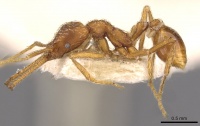Strumigenys rehi
| Strumigenys rehi | |
|---|---|

| |
| Scientific classification | |
| Kingdom: | Animalia |
| Phylum: | Arthropoda |
| Class: | Insecta |
| Order: | Hymenoptera |
| Family: | Formicidae |
| Subfamily: | Myrmicinae |
| Tribe: | Attini |
| Genus: | Strumigenys |
| Species: | S. rehi |
| Binomial name | |
| Strumigenys rehi Forel, 1907 | |
This species was taken from orchid plants arriving at Hamburg, Germany, a circumstance agreeing with the large eyes of the worker to indicate an arboreal habitat. (Brown 1962)
Identification
Bolton (2000) - A member of the cordovensis complex in the Strumigenys mandibularis-group. This is the only species of the cordovensis-complex to lack standing pilosity of any form on the first gastral tergite. The pilosity that it does have on this segment is not duplicated by any other species in the complex.
Keys including this Species
Distribution
Latitudinal Distribution Pattern
Latitudinal Range: -3.1° to -3.1°.
| North Temperate |
North Subtropical |
Tropical | South Subtropical |
South Temperate |
- Source: AntMaps
Distribution based on Regional Taxon Lists
Neotropical Region: Brazil (type locality), Colombia.
Distribution based on AntMaps
Distribution based on AntWeb specimens
Check data from AntWeb
Countries Occupied
| Number of countries occupied by this species based on AntWiki Regional Taxon Lists. In general, fewer countries occupied indicates a narrower range, while more countries indicates a more widespread species. |

|
Estimated Abundance
| Relative abundance based on number of AntMaps records per species (this species within the purple bar). Fewer records (to the left) indicates a less abundant/encountered species while more records (to the right) indicates more abundant/encountered species. |

|
Biology
Castes
Nomenclature
The following information is derived from Barry Bolton's Online Catalogue of the Ants of the World.
- rehi. Strumigenys rehi Forel, 1907e: 3 (w.) BRAZIL. See also: Brown, 1958c: 222; Bolton, 2000: 538.
Unless otherwise noted the text for the remainder of this section is reported from the publication that includes the original description.
Description
Worker
Bolton (2000) - TL 3.3-3.7, HL 0.72-0.78, HW 0.55-0.61, CI 76-78, ML 0.72-0.76, MI 97-100, SL 0.62-0.65, SI 107-113, PW 0.35-0.40, AL 0.76-0.84 (2 measured).
Characters of cordovensis complex. Ground-pilosity on head and promesonotum dense and conspicuous, curved spatulate; on propodeal dorsum the lateral margins each with a row of posteriorly curved spatulate hairs. Similar dense spatulate pilosity, which is curved posteriorly, is present on dorsum of petiole and postpetiole. First gastral tergite without standing hairs, but with moderately dense minute pointed slender hairs that are appressed and directed posteriorly, these hairs almost pubescence-like in appearance. Apicoscrobal hair present. Cephalic dorsum with a single pair of erect stiff hairs near occipital margin. Pronotal humeral hair stiff, standing hairs otherwise absent from mesonotum, petiole and postpetiole. Tergites behind first with a few fine elongate simple hairs. Distal preapical tooth only slightly closer to apicodorsal tooth than to proximal preapical tooth; all teeth spiniform. Gland bullae proximal of midlength on dorsal surfaces of middle and hind legs. Propodeal declivity with two acutely triangular lobes that are linked by a broad lamella, the ventral lobe longer and somewhat narrower than the dorsal. Head and alitrunk reticulate-punctate except for mesopleuron which is mostly smooth. Disc of postpetiole weakly sculptured with scattered minute rugulae. Gaster smooth behind the short but sharply developed basigastral costulae.
Type Material
Bolton (2000) - Syntype workers, BRAZIL: Amazonas, Manaus, with orchids (intercepted by Plant Quarantine, Hamburg) (Musee d'Histoire Naturelle Genève, Zoologisches Institut und Zoologisches Museum der Universität Hamburg) [examined].
References
- Bolton, B. 2000. The ant tribe Dacetini. Memoirs of the American Entomological Institute. 65:1-1028.
- Brown, W. L., Jr. 1958c. The neotropical species of the ant genus Strumigenys Fr. Smith: group of cordovensis Mayr. Stud. Entomol. (n.s.) 1:217-224. (page 222, redescription of worker)
- Brown, W. L., Jr. 1962c. The neotropical species of the ant genus Strumigenys Fr. Smith: synopsis and keys to the species. Psyche. 69:238-267.
- Forel, A. 1907d. Formicides du Musée National Hongrois. Ann. Hist.-Nat. Mus. Natl. Hung. 5: 1-42 (page 3, worker described)
References based on Global Ant Biodiversity Informatics
- Bolton, B. 2000. The Ant Tribe Dacetini. Memoirs of the American Entomological Institute 65
- Fernández, F. and S. Sendoya. 2004. Lista de las hormigas neotropicales. Biota Colombiana Volume 5, Number 1.
- Kempf, W.W. 1972. Catalago abreviado das formigas da regiao Neotropical (Hym. Formicidae) Studia Entomologica 15(1-4).

